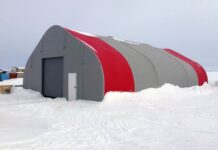New construction starts in September receded 1% to a seasonally adjusted annual rate of $419.5 billion, according to McGraw-Hill Construction, a division of The McGraw-Hill Companies.
Both nonresidential building and housing fell back after their improved pace in August. Meanwhile, the nonbuilding construction sector, comprised of public works and electric utilities, strengthened for the second month in a row after weakening in early summer. For the January-September period of 2011, total construction starts on an unadjusted basis were reported at $314.1 billion, down 5% from the same period a year ago.
The September statistics lowered the Dodge Index to 89 (2000=100), compared to the August reading of 90. “The volume of construction starts continues to hover within a set range, not yet able to gain sufficient momentum for expansion to take hold,” stated Robert A. Murray, vice president of economic affairs for McGraw-Hill Construction. “For a variety of reasons, this extended plateau is likely to last a while longer. Tight budget conditions at the federal, state, and local levels of government are restraining the amount of construction that’s taking place for the institutional building and public works sectors, notwithstanding the occasional upturn such as shown by public works in September. The slow pace of job creation and widespread uncertainty about the economy are causing developers and lenders to remain hesitant about new commercial projects, and they’re also causing potential homebuyers to remain wary about going ahead with home purchases.”
Nonresidential building in September dropped 13% to $131.8 billion (annual rate). The institutional side of the nonresidential market retreated overall, pulled down in particular by a 24% drop for healthcare facilities after the 92% jump for this category in August. Several very large hospital projects, valued each in the range of $164 million to $385 million, had provided the August lift. While September showed that large hospital projects continued to reach groundbreaking, they were generally smaller in scale than what had been reported in the prior month. The large hospital projects in September, valued each at $100 million or more, were located in Delaware ($180 million), Colorado ($128 million), New York ($109 million), Illinois ($104 million), and California ($100 million). Also falling sharply in September were the public buildings category (comprised of courthouses, detention facilities, and military work) which plunged 36%; and the amusement-related category which dropped 22%. Cushioning the institutional downturn was a slight 1% increase for educational buildings, helped by the start of two large college buildings, valued each at $92 million, located in Philadelphia PA and San Diego CA, with additional support coming from the start of a $79 million high school in Yakima WA and a $71 million high school in Virginia Beach VA. Church construction in September edged up 6% from a low level, and the often volatile transportation terminal category advanced 90%, reflecting the boost coming from a $132 million project to rehabilitate and retrofit rail substation and ventilation facilities in Queens NY.
The commercial building categories in September featured large declines for warehouses, down 48%; and hotels, down 21%. Office construction in September improved 11%, helped by the start of a $100 million data center in Suwanee GA and an $80 million renovation of a federal office building in Houston TX. Store construction also saw greater activity in September, rising 15%. The manufacturing plant category in September fell 45%, continuing to retreat from its heightened activity in June and July.
Residential building, at $127.6 billion (annual rate), decreased 2% in September. The decline was due to a slower pace for multifamily housing, which fell 9% in September after witnessing gains the previous two months. Even with this downturn, the multifamily housing category in September included the start of several large apartment projects, located in Chicago IL ($88 million), San Francisco CA ($70 million), Willingboro NJ ($56 million), Washington DC ($55 million), and Addison TX ($54 million). For the first nine months of 2011, multifamily housing was up 10% in dollar terms compared to the same period a year ago, due to this behavior by major region – the South Atlantic, up 27%; the West, up 24%; the Northeast, up 10%; the South Central, down 2%; and the Midwest, down 8%. Single family housing in September held steady with August, as the pattern of recent months suggests that activity is stabilizing at a low volume after the declines shown earlier in 2011. On a year-to-date basis, single family housing in dollar terms was down 5% from the same period a year ago, due to this behavior by major region – the South Atlantic, down 2%; the South Central and West, each down 5%; the Midwest, down 8%; and the Northeast, down 13%.
Nonbuilding construction in September climbed 11% to $160.0 billion (annual rate), the third highest monthly rate for nonbuilding construction so far this year. While the highway category has generally slipped back in 2011, given the waning federal stimulus support, the month of September featured a 50% increase for highway construction. Large projects that aided the September highway total were $1.1 billion for a highway tunnel project in Seattle WA, plus two large highway projects in North Carolina valued at $115 million and $112 million, respectively. Bridge construction also increased in September, rising 24%, with large bridge projects starting in Connecticut ($166 million) and New York ($109 million). The “miscellaneous” public works category, which includes pipeline and mass transit work, climbed 25% in September and was helped by the start of a $300 million carbon dioxide gas pipeline in Wyoming and a $164 million mass transit project in Colorado. For the environmental public works categories, water supply systems grew 18% in September, but decreased contracting was reported for sewers, down 28%; and dams/water resources, down 74% (following the elevated amount in August that included $1.5 billion for work on the Olmsted Dam in Kentucky). The electric power category had a particularly strong showing in September, advancing 52% from the previous month. Large projects that lifted the September electric utility total were the following – a $2.2 billion solar power plant in California, a $310 million natural gas fired power plant in California, a $302 million wind farm in Kansas, a $216 million wind farm in Nevada, and a $150 million geothermal power plant in Nevada.
The 5% decline for total construction on an unadjusted basis during the first nine months of 2011 was the result of reduced contracting for each of the three major sectors. Nonresidential building dropped 9% year-to-date, as a 16% slide for institutional building outweighed a 3% gain for commercial building and a 27% increase for manufacturing building. Residential building was down 3% year to date, the result of the 5% slide for single family housing combined with the 10% gain for multifamily housing. Nonbuilding construction fell 2% year-to-date, with public works down 18% while electric utilities soared 100%. By geography, total construction starts performed as follows in the first nine months of 2011 relative to last year – the West, up 8%; the South Atlantic, down 4%; the South Central, down 6%; the Midwest, down 11%; and the Northeast, down 14%.



































